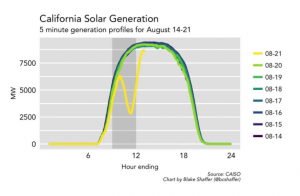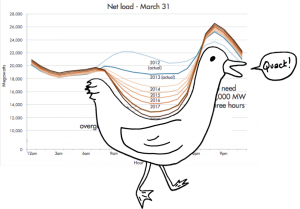On Aug 21st, 2017, California solar energy grid survived the Solar Eclipse Test without any black outs!
As solar production declined, the California grid managers obtained more supplies from natural gas-fired power plants and hydroelectric dams, executing plans they have been crafting for months. It also imported power from neighboring states to compensate for the loss of solar production.
 “Things went really, really well,” said Eric Schmitt, vice president of operations at CAISO.
“Things went really, really well,” said Eric Schmitt, vice president of operations at CAISO.
Informed customers who choose to conserve their peak time usage are vital in helping to maintain grid stability. As energy demand evolves customer-sided technologies are responding — not only during eclipse conditions, but also on a day-to-day basis, especially the need for an advanced energy storage system.
Solar Forward offers battery storage systems that help the utilities by using homeowner battery energy during peak demand time periods and save consumers considerable money! Sunverge, Tesla and other systems that Solar Forward installs, are eligible for SGIP rebates and tax credits that make these systems very cost effective and provide emergency power should the grid fail due to an earthquake or any power outage.
“We are selling and installing battery back up systems in record numbers,” said Mark Smith CEO of Solar Forward, “Consumers want secure power for uninterrupted service, to save money and feel they are part of the future of our national electrical grid. We now have cost effective options for consumers.”
Peak demand increases dramatically from 4 PM to 10 PM. This “Duck Curve” is a huge challenge for utilities to ramp up power production in the evening. Utilities often more than double the price of energy in the evening. Grid resilience requires people to think about their power making choices,” said Picker. “Whether it’s to get a rooftop solar … or to get more energy-efficient appliances.”
 “A battery storage system is a great investment that insolates our clients from peak energy rates,” says Mark Smith.
“A battery storage system is a great investment that insolates our clients from peak energy rates,” says Mark Smith.
Residential solar customers in California are already moving to time-sensitive electricity rates. By 2019, all residential customers will switch to a time-of-use (TOU) plan. This incentivizes customers to use energy at off-peak times, and enable them to save money coupled with an investment in advanced energy storage.
Picker quoted Sacramento Municipal Utility District’s TOU pilots as evidence of this. The two-year study, conducted in partnership with the Rocky Mountain Institute, successfully reduced demand by nearly 12 percent during the peak period. With a larger price differential, the utility was able to shave around 25 percent of load during peak hours on peak days.
Picker sees the absolute importance to explore demand-side management and provide the customers with more choice. The results suggest that if around 15 percent of SMUD’s customer base could reduce their load on 12 peak days in the summer, the utility could avoid building 500 megawatts of gas peakers, said Picker. “That’s not chump change; that’s a big deal.”
As the price for renewable energy and energy storage continues to plummet, and the California utilities switch towards a TOU plan, our consumers are achieving greater savings and grid resilience by simply obtaining a quality battery storage system and carefully planning their energy usage.
Solar Forward can design your battery storage system and calculate your savings. Give us a call for a free site visit and evaluation! 310-213-0790
